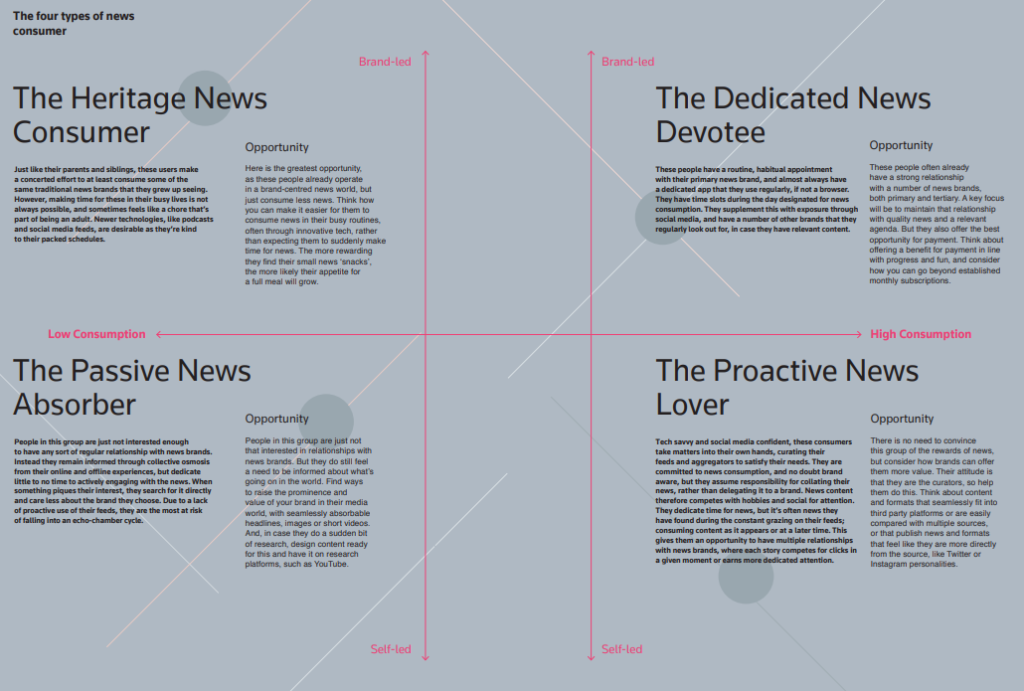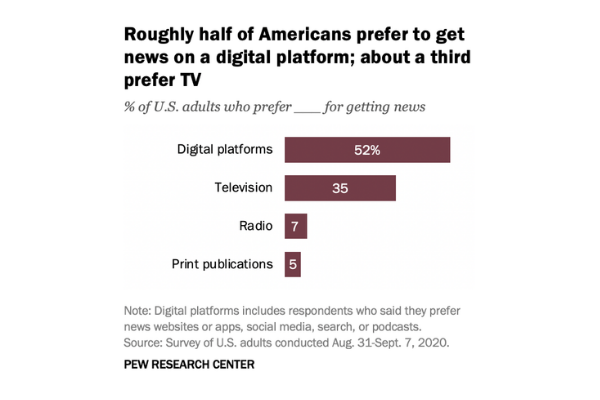Out With the Old, In With the New?
By Amal Abdallah, Account Executive
My mom often tells me that I need to watch more news. To her, that means watching TV to get the news and I’m not sure my mom would understand why I don’t turn on the TV to get my daily fix. She is from the Baby Boomer generation.
Although she’s started to livestream some of her news, she is very much glued to the TV. I grew up in a household where we watched the news every night. I was forced to learn about subjects that may or may not have interested me, and it felt like a chore.

Forever Young
Being a Millennial (I just turned 33, don’t confuse me with a Gen Z), I have actually had the opportunity to get my news in multiple ways throughout my life. I consider myself to be very lucky – I live in an age where there are seemingly endless ways for a person to get news. I’ve read printed newspapers, viewed regular nightly news broadcasts, listened to news radio; and, more recently, used the internet, publication apps, social media, RSS feeds, alerts and email to stay up to date.
Let’s take a moment to remember the core role of news: to inform us of what is going on in the world, allowing us to connect our daily life with the world around us and satisfying a vital human need.
My use of traditional media to get news is declining which has been caused by the invention of the smart phone and its takeover of social media. We not only can get all the “need-to-know” news digitally, but also the “interesting-to-know” or “useful-to-know-now” items. Traditional methods are no longer convenient for someone like me. I am on the go and I don’t have time to sit down and watch the news or enjoy my morning coffee with the paper.
The smartphone makes it easy to get whatever news we want in the palm of our hands, on demand and on the go. No longer does it feel like a chore to stay informed. I’ve even signed up for an email service that delivers the news directly through email. This solves the problem of what do I need to know as alerts, emails, notifications keep me up to date … in real time.
Breaking It Down
I am not alone in my view that traditional media is on its way out. In a survey conducted by The Media Insight Project, results showed that among Americans who own a smartphone, “those who use more technology are more likely to report that they enjoy keeping up with the news and are more likely to say that it’s easier to keep up with the news today than it was five years ago.”
Additionally, the majority of adults 30+ are more likely to consume news more than once per day (59%), but in any age group, the majority of adults consume news daily.
It’s no surprise that younger adults (Millennials and beyond), are interested in a variety of topics, and that the mediums they use to discover that news would follow suit based on age. Older adults mainly rely on TV, radio and good old-fashioned print media for news, whereas younger adults will turn to their mobile device.
In the same survey, “young adults are significantly more likely than older adults to say they used their cell phone to get news in the last week. Seventy-five percent of adults age 60 and over say they read print publications in the past week versus 61 percent of adults age 40-59, 55 percent of adults age 30-39, and 47 percent of adults age 18-29.”

Younger generations – contrary to popular belief – are actually active consumers of news, especially breaking news. Additionally, almost all Americans will follow slower news trends or other topics of interest to them, including politics and government, local news, weather, sports and business.
Something I Didn’t Know …
Did you know there are four groups of news consumers?
- The Heritage News Consumers
- The Dedicated News Devotee
- The Passive News Absorber
- The Proactive News Lover
I fall into the Proactive News Lover. The chart below dives deeper into this profile. I would wager that there is a great deal of other Millennials who fall into this group as well. Where do you fall?
I think the best way to describe a Proactive News Lover is that they love to graze on news throughout the day; and get their news from various sources because they aren’t committed to one particular source. Where they go also depends on the content that is being shared, so a Proactive News Lover will be highly engaged but on their own terms, and likely through updated news feeds when they have spare time to catch up.
This was spot on for me and extremely interesting to learn. Check out the full report and see where you fall here.

Stop the Presses!
This isn’t an attempt to say that traditional media are no longer relevant – it’s actually the opposite. Who doesn’t want to have their face on the front page of The New York Times?
However, the elephant in the room is that newspaper circulation has fallen. In fact, in 2018, newspaper circulation was at its lowest level since 1940, and in the 10-year span between 2008 and 2018, newspaper revenue declined dramatically.

It’s a sign of the times: Digital is taking over everything. Even the newspaper now has a digital edition and a lot of folks go straight to that source when on the go.
For those readers who enjoy charts and graphs, here are a few interesting findings that speak the loudest when it comes to this digital divide.




It’s Not Just News Anymore; It’s an Experience
Traditional news brands will need to continue to adjust their formats, tone and topics if they want to win over younger generations. This doesn’t mean that younger people aren’t looking to be informed, but our expectations are different. We’re looking for news that adds value to our lives, not just society. We always ask ourselves ”How is this affecting my life?” or “What does this information mean to me?” That personal context is more important than ever.
I’ve seen more and more news-related sources that deliver content that is interesting or just fun to know, and I find myself going back to those sources frequently. There is no one-size-fits-all solution, but that seems to be how the news business will be going forward.
Information must be accessible, stories must fit the bill for younger audiences and they have to be delivered in a timely and convenient manner. Although we often grow tired of bad news, we don’t want the media to disregard those hard-to-tell stories. Someone has to tell them! We crave these stories, points of view, human touches, authenticity and diversity.
At Foster Marketing, we say engaging, creative, relevant content will always be king. Why would telling news stories be any different?
We are firm believers that creating engaging content that audiences will sink their teeth into is a must. Contact us today to discuss how our team can assist you with getting the creative ideas going and enhance your marketing efforts. Let’s get started! Call us today at 281-448-3435, contact us online
BONUS TIP
When adding videos to social media and websites, consider adding closed captions.
According to the American Press Institute, ” about 85 percent of video on Facebook is watched without sound. Facebook has built a video system that encourages watching without sound: Videos autoplay in the new feed and are muted by default.”


